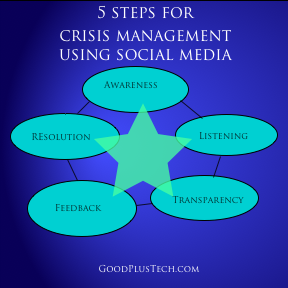
Today, good news -- or bad news -- breaks in real time. And anything can go viral in short order. This is great for cute babies laughing in videos, or heart-warming tales of good deeds. It's not great, however, for the unexpected, semi-inevitable crisis that any organization can face suddenly. Luckily, nothing in the social media world is too much different than in the "real world." Quotes emphasizing that, like it or not, they are virtually the same now -- online and offline worlds.
So how can one be prepared?
"The time to repair the roof is when the sun is shining."
-- John F. Kennedy
Thinking about and detailing a crisis management plan in advance is of course ideal; getting at least prepared with the basics is a necessity. One critical component of planning on a small or large scale is social media strategy. A 2012 Gartner study reports, "75% of organizations with BCM [Business Continuity Programs] will have public social media services in their crisis communications strategies by 2015." And why is that?
It's because the fastest way to spread any message now is via social media.
Outlined below are five steps organizations can take to help successfully navigate and manage a crisis smoothly, using social media.
Although these steps do have a definitive chronological order, the diagram [below] includes a star pattern across the five areas, indicating that as things progress, new information and feedback emerges. And positive progress is made, the steps become more fluid.

Awareness
Social media is most beneficial to everyone when it is conversational and engaging. Part of that is being aware of the conversations happening. Although some people are hesitant to "get involved with social media," the fact is, every public and private organization is already involved with social media.
Think of social media like this: If you walk into the center of a crowded room, and then cover your ears with your hands, people don't stop talking; you only stop hearing what they're already saying.
How do you stay aware? By monitoring the outside social media world. Keeping tabs on the major platforms, like Twitter, Facebook, Google Plus, LinkedIn, YouTube and blog comments keeps companies informed. This can be as simple as setting up free Google alerts. Or, there are numerous platforms available to make listening (and interacting) simple, even with large teams. A few currently popular choices would include Hootsuite, CoTweet , Sprout Social, Argyle, Radian6, Sysomos, and Vitrue. Some of the more sophisticated tools even track Sentiment, meaning whether mentions are positive or negative overall... which can be a good heads-up that somethings amiss if sentiment suddenly turns more negative.
With any of these, including Google alerts, here are a few key things to track:
•Organization name
•CEO and other high-profile people
•Marquee products or services by name
•Social media accounts (if not tracking with social media tools)
•Your blog name
•Your events
•Competitors
Listening
"There is a difference between knowing the path, and walking the path."
-- The Matrix
Awareness is important, but what next? Unless one side is listening while the other is talking, there's no conversation happening.
Where there isn't conversation, there's everything else: opinion, gossip, hearsay, irritation, confusion, assumption. None of these are ideal for organizations that pride themselves on trust, credibility, honesty and two-way communication.
So what does "listening" mean? It means noticing, and responding, to comments and social media mentions. It also means not deleting negative comments (unless extremely profane, abusive, racist or otherwise severely questionable), as that is equivalent to hanging up on someone who calls customer service. That almost always backfires and makes the person not only more angry, but also more prone to escalate their negative comments. At that point, when feeling "dismissed," people are more likely to mention their annoyance to their social media networks, which can rapidly become viral, in a bad way. And most of the time, exactly like in the "real world" (vs. online), a few things become important.
These are things your customers want during a crisis:
•Feeling like I'm heard.
•Feeling like my opinion matters.
•Feeling like someone hears me and will do something.

Hmmm... Is there trouble brewing? Photo by Amy Neumann
Transparency
Updates should be as real-time as possible. Don't admit fault if it's not determined, but at the same time, acknowledge the hardship that the confusion or changing circumstances warrant. And when it's clear the fault lies within, acknowledge it, thank people for their feedback, and say how and why it won't happen again. People want the real story, and appreciate it -- even more than "perfection."
Transparency shows in statements like these:
•We are aware of the issue, live updates are here: (site URL)
•Here's what we're doing to solve it
•Here's how we'll prevent it in the future
•Thank you for your patience and feedback
Feedback
This step is important, and not too far from listening. But in addition to hearing what people are saying, it's critical to let them know they're being heard. Providing feedback can be as simple as "Thank you for your feedback, more details are available at ___," or for more complex matters, provide and email address they can send messages to for deeper interaction. Then, of course, follow up. At the feedback stage, it's all about helping customers/constituents feel "in the loop," like they are being heard, because someone is responding.
Feedback to the broader audience as a whole is also vital. Some ways to do this are through updates on websites and blogs, YouTube videos from executives or others within the company providing updates (normal quality is fine -- it's about the message, not the medium), Facebook updates, Tweets, LinkedIn status updates from executives, and posts on Google Plus.

Now we're getting somewhere... Photo by Amy Neumann
Resolution
Any crisis should at some point, hopefully quickly, come to a resolution. If the steps above have been happening ongoing, when there is resolution, it will be quick and easy to update those affected, using social media. The messaging at this point should thank people for their feedback and patience, outlining what the solution was, apologizing as needed, and reassuring customers that this has been a learning lesson and steps are in place to avoid a similar situation in the future. This messaging should flow through all social media channels, as well as be presented to the media, and posted on websites and blogs.
And at this stage, like all the other stages, the principles of listening for understanding, being empathetic and polite, and being helpful are key. If it feels like the stages have almost morphed into one fluid loop, you're probably doing a great job.

Ahh. Much better. Transparency and feedback triumph again! Photo by Amy Neumann
Summary
A good company can shine bright in the face of adversity or crisis. The expectation is not perfection, but real, honest, understanding, helpful behavior during and after a crisis. With a goal to make things right during and after an issue, social media is an ideal tool to make that process as smooth, easy, and fast as possible for both sides.
"The reward of a thing well done is having done it."
-- Ralph Waldo Emerson
Social Media Can Save the Day
In a crisis, these five steps can make things smoother and easier for customers and company alike.
Awareness
•Stay on top of conversations about your company with simple tools
•Watch for sudden changes in tone and sentiment from positive or neutral to negative
•Set up and monitor keywords related to your business
Listening
•Monitor who is talking to you across social media platforms and website comments
•Respond, both individually and more broadly
•Use updates on the same platforms someone talks, and invite them to email you if deeper interaction is needed
Transparency
•Acknowledge there is a situation
•Keep real-time updates flowing
•Be honest and straightforward with details
Feedback
•Make sure customers feel heard by replying, directing them to resources for updates
•Answer questions directly
•Be gracious for their feedback, and don't delete negative comments
Resolution
•Update social media platforms with outcome, update websites
•Notify the media for additional outreach
•Outline the resolution, what was learned, and how similar situations will be prevented in the future
Amy Neumann is a social entrepreneur, writer, speaker and consultant on social good marketing. Check out her Charity Ideas Blog and follow her on Twitter @CharityIdeas.
